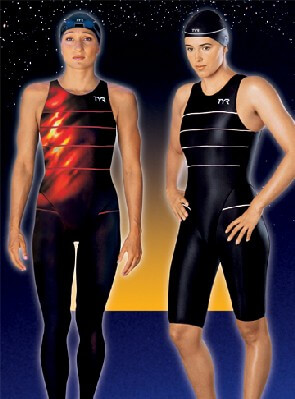INDUSTRY NEWS: TYR Announces New Swim Suit Technology Developed By TYR & University of Buffalo

HUNTINGTON BEACH, Calif, March 8. First Time Water Drag Quantified & Decomposed “The difference between finishing first and coming in second in competitive swimming is measured in hundredths of a second, so when a swimmer's technique and fitness is as good as it gets, a coach turns to one remaining variable to sharpen the competitive edge — the swimsuit,” notes Steve Furniss, Founder and Executive Vice President of Huntington Beach, CA-based swimsuit manufacturer TYR and former Captain of the U.S. Olympic Swim Team.
In the swimsuit scenario, scientists at the Center for Research and Education in Special Environments at the University at Buffalo (UB) may be the coach's best friends. They have a patent pending on a structural element that can improve a swimmer's time by decreasing the force water exerts on swimmers, called "drag," by 10 percent when incorporated into the swimsuit design.
The new element, called a trip-wire, or turbulator, alters the fluid dynamics of water as it flows over and around the swimmer. How drag acts on a body moving through water plays an important role in the amount of energy a competitor must exert to cover a specific distance: less drag, less energy required, quicker finish.
Trials of suits incorporating the turbulator showed adding the element could improve a swimmer's time by 3 percent, said David Pendergast, Ed.D., UB professor of physiology and biophysics. Pendergast and Joseph Mollendorf, Ph.D., UB professor of mechanical and aerospace engineering, were senior researchers on the project.
The turbulator's development is grounded in the team's earlier work in fluid dynamics and their success in decomposing drag, breaking it into its component forces. "No one else had done it before," Pendergast said.
"We discovered there are three types of drag. Friction drag, the force of water molecules as they pass over the body, is dependent on how long the body is. Pressure drag, the strongest force, results from pushing the water out of the way. Wave drag occurs at relatively high speeds and is the force exerted by waves created."
When they broke drag into its three components, they found that pressure and friction drag exerted the highest influences, said Pendergast. Their next question was: How can drag be reduced?
Their first inclination was to change the surface of the swimsuit fabric, but that approach didn't reduce drag significantly. Enter the turbulator, a strategically placed fabric-encased flexible tube that introduces a raised ridge on the suit. Pendergast describes how this element improves the fluid dynamics of a swimmer.
"When water hits the shoulders of a swimmer, it separates from the body, which creates drag. By adding a turbulator, we cause water to follow the body instead of separating from it. This change increases friction drag, but reduces pressure drag. We found that placing a turbulator on front and back significantly reduced pressure drag, overcoming the increased friction drag and adding a competitive advantage"
Over the past two years, the team tested 20 suit models incorporating the turbulator for TYR. The trials took place in the Center's circular pool designed for measuring drag and other hydrodynamic properties, and in UB's competition pool.
"The work was part theory and part practice," said Pendergast. "It turned out the size of the turbulator was crucial. We'd predict how a certain size and placement would respond, TYR would build the suit, and we tested and retested."
The final design, called "Aqua Shift," incorporates a series of turbulators positioned on the suit front, across the shoulders and across the hips. UB research on suit design had shown that suits that cover the swimmer from shoulder to knee or ankle produce less drag than suits with less coverage.
The TYR Aqua Shift bathing suit is available to the public and will be worn by athletes at the Olympics in Athens this summer.
Named after the mythical Norse god of war, the TYR brand embodies the competitive spirit of sports and is a symbol of courage and victory. Founded in 1985, TYR has passionately dedicated itself to redefining the next generation of performance and recreational swimwear, while continuing to be the model of leading edge innovation and style.



